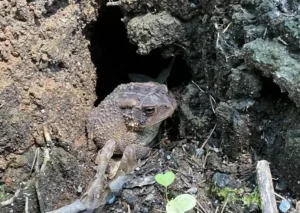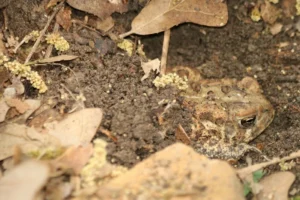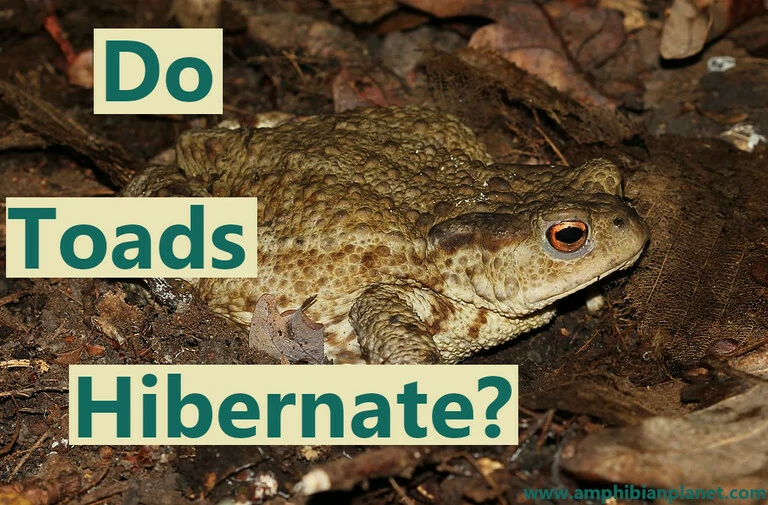In the winter, we do not see many frogs and toads. This is because they are ectothermic (cold-blooded) animals, meaning they can not regulate their internal body temperature. When the environmental temperatures rise or fall, so does their internal temperature.
Toads in cold regions hibernate to protect themselves from freezing temperatures in the winter. This could be under logs, rocks, in deep leaf litter, soft sandy soil, or in small underground burrows below the frost line.
That being said, it’s important to note that “hibernate” is a slightly inaccurate term. The correct term is “brumation”.
Hibernation is a term reserved for warm-blooded (endothermic) animals such as groundhogs and squirrels. Brumation refers to almost the same thing but in cold-blooded animals.
Toads Technically Don’t Hibernate, They Brumate
Brumation is very similar to hibernation. In fact, many people use these two terms almost interchangeably. However, there are some differences between these two concepts.
The Differences Between Hibernation and Brumation
Hibernation |
Brumation |
| Hibernation is voluntary | Brumation is involuntary |
| Hibernating animals still require lots of oxygen | Brumating animals have extremely low oxygen requirements. |
| Hibernating animals are not easily disturbed by temperature fluctuations and sleep through most of the winter | Brumating animals are easily disturbed by fluctuations in temperature and will be active on warm days in the winter |
Hibernation is when an endotherm (warm-blooded animal) such as a squirrel voluntarily reduces its activity and lowers its metabolism to conserve energy when sufficient food is not available.
During hibernation, the body temperature falls, and the heart and breathing rate slow down. Think of it like going into a very deep sleep for an extended period.
Brumation, on the other hand, is when an ectotherm (cold-blooded animal) such as a salamander or toad involuntarily enters a state of dormancy when the temperatures fall.
Cold-blooded animals cannot regulate their internal body temperature, so they are forced into dormancy when the temperatures fall. If they were to be active, they would freeze solid and die. A significant difference between hibernation and brumation is the oxygen requirements of the animal.
A significant difference between hibernation and brumation is the oxygen requirements of the animal.
Although hibernating animals have reduced oxygen requirements, they still need lots of oxygen to survive. In contrast, brumating animals have extremely low oxygen requirements.
Also, hibernating animals sleep through most of the winter (although to do occasionally wake up).
Brumating animals on the other hand will be active on warm days of the winter. If the weather is mild, they may come out of dormancy and bask in the sun before re-entering dormancy. Even if happens in the dead of winter.
However, despite these differences, I will stick to the well-known term “hibernation” to keep things simple. When I use the word “hibernation”, you know I really mean “brumation” ;).
Toads “Bulk-Up” to Prepare for Hibernation
As winter approaches, toads instinctively know to start preparing for hibernation. This is typically after their mating season ends.
Toads will start to eat more than normal, to put on good body weight and create energy reserves to maintain important bodily functions during hibernation.
After bulking up, they will voluntarily stop eating, become less active, and start to sleep a lot. This is usually just before the start of hibernation.
Most Toads Toad Hibernate Underground
Since there are so many toad species. The exact place a toad will hibernate differs among different species.
However, most toads will hibernate underground, where the frost does not penetrate. This could be in natural holes or abandoned mammal burrows that are deep enough that the frost does not penetrate all the way to the bottom.

However, some toads will dig their own hibernacula (hibernating space).
To do this, they dig deep down into loose soil. Toads have special, hardened knobs on their hind feet that help them dig into the soil. They use their back legs to ‘knead’ their bodies into the soil, submerging themselves completely until they are below the frost line.
Toads will die if they freeze, so they need to stay below the frost line all winter.
How deep they dig varies from year to year depending on the temperatures and snow cover. They will burrow anywhere from 6 inches to over 3 feet deep; they tend to stay a couple of inches of the frost line and will move up and down throughout the winter as the frost line changes.
Some Toads Hibernate Above-Ground
Rather than hibernating underground, some toads will spend the entire winter above ground. This could be in old tree stumps, in deep leaf litter, or under rocks, logs, and log piles in wet areas.
Toads in urban areas will sometimes seek out foundations where cracks exist and burrow their way down into those crevices.
The most ideal hibernaculum (hibernating space) is somewhere moist that stays frost-free all winter. It shouldn’t be warm, it should just be protected from the frost.
Research suggests that many toads are loyal to their overwintering sites and will return to the same place every year. However, some toads are not very picky and will overwinter in a variety of sites.
How Toads Hibernate
When toads enter hibernation, several changes in behavior can be seen.
To protect the eyes from dirt and debris that could damage them, the toad raises a special “eyelid” called a nictitating membrane. At the same time, the eye is pulled closer into the head.
How the most significant change is with respiration.
During hibernation, toads do not get as much oxygen as they do when they are above ground, so suffocation is a real possibility. However, they have a way to get around this.
Since toads are ectothermic (cold-blooded) animals, the lower temperatures during the winter drastically lower their metabolism and reduce their oxygen demand.
The oxygen demand is lowered to the point where all the oxygen needs can be met by absorbing oxygen from the surrounding soil via the skin (cutaneous respiration).
Since the lungs are not in use, most of the blood moves to the skin to maximize the amount of oxygen absorbed. This can sometimes be observed when the light skin on their bellies turns pink to reddish from the increased blood flow.
As the toads begin to come out of hibernation start to breathe again. Less blood is in the skin, so it becomes whiter.
How Long Do Toads Hibernate?
Most toads can only hibernate for three to five months before they will have to get active again. In North America, this is usually between December and March.
If the temperatures drop and remain cold for extended periods, most toads will not survive.
However, some toads can hibernate for as long as 6 months.
Spring Temperatures Bring Toads Out of Hibernation
When the snow starts to melt and the weather gets warmer, toads and other amphibians will emerge from hibernation. This is because their metabolic rates get high enough to allow them to be more active.

During this time, toads will migrate to breeding ponds looking for mates. After mating, the female toads will lay dozens of eggs in long strings (one to three eggs wide) along plants or on the bottoms of shallow water in ponds.
After a few weeks, tiny tadpoles will hatch from these eggs, and live an entirely aquatic life until they go through a process known as metamorphosis and transform into young versions of the adults.
These baby toads (typically half an inch long) then leave the water, to live a mostly terrestrial life, only returning to the water to breed.
Some Toads Sometimes “Hibernate” in the Summer
Freezing temperatures aren’t the only thing toads have to worry about. Being cold-blooded animals, high summer temperatures are just as undesirable as the cold. This is where estivation (also spelled as aestivation) comes in.
Estivation is when an animal enters a state of dormancy to conserve energy when the environmental conditions are very hot and dry.
The breathing rate, heart rate, and general metabolic rate all decrease, just as they do in hibernation. Think of it as some sort of summer hibernation.
If the summer weather gets too harsh, toads will find a cool moist place and estivate as they wait for the rain to come and the temperatures to drop. If the rain comes, but the temperatures remain high, they will not emerge until the temperatures are cooler.
What to Do if You Find a Hibernating Wild Toad
If you find a hibernating toad, it’s best to leave it alone. Do not touch it, pick it up, or move it to another location. Disturbing a hibernating amphibian could cause it to prematurely come out of hibernation, which can be fatal to the animal.
However, if you have already disturbed the toad, there are several things you can do to improve its chances of survival.
The first thing to do is to put it back where you found it. If you forget the exact place it was or are otherwise unable to put it back where you found it, place it somewhere where it will be protected from frost and predators such as cats or owls.
This could be in a log pile, in a compost heap, or in any other safe area. The hibernaculum (hibernating place) you chose shouldn’t be warm, it should just be protected from the frost.
How to Help Wild Toads Hibernate
If you live in a region that experiences freezing temperatures in the winter, and you frequently see toads in your yard – you can offer the toads a safe place to spend the winter. To do this, you will need to build a hibernaculum (place to hibernate)
You will need a drainpipe cut-off or a cement pipe (if using plastic drainpipes, roughen the insides with sandpaper, so that they are not too slippery for toads to climb).
- Choose a sunny place in your yard with well-drained, loose soil.
- Dig a hole about 50cm deep.
- Position the pipe in the hole so that one end protrudes about 2 inches above the soil (forming an entrance hole) and the rest of the pipe slants down into the trench at a 30-degree angle.
- Fill the hole with soil to support and cover the slanted pipe.
- Pour in loose sand to fill the pipe halfway, and fill the rest of the pipe with composted leaves.
When winter comes, a toad will dig deep into the sandy layer. After the toad tucks itself in, you can bury the protruding pipe end in compost or leaves for extra insulation. Remember to remove this layer before spring arrives so the sun can warm the soil.
As a bonus, you can plant grass around the hibernaculum to make it more “natural. ” Just don’t cover the entrance and make sure it is very clearly visible so toads can see it.
Hibernation in Captive toads
Toads only hibernate out of necessity. If a toad is kept in a place with optimal temperatures and adequate food available all winter long, it does not need to hibernate. This means captive toads kept in a controlled environment generally do not need to hibernate.
Remember, hibernation is a way for animals to survive the freezing winter temperatures. Wild amphibians have to hibernate or they would freeze solid and die.
In captivity, toads will not face any of the problems that cause them to hibernate in the wild.
However, if a captive toad is not kept at a controlled temperature. It will enter a state of torpor and hibernate when the temperatures fall, just as it would in the wild.
Signs that a captive toad is preparing to hibernate include;
- Deep burrowing in its enclosure
- Very little activity for extended periods
- Sleeping more frequently
- Very little appetite
In the wild, toads will come out of hibernation when the warm and wet spring weather comes. In captivity, you can encourage your toad to come out of hibernation by gradually increasing the temperature and humidity levels in its habitat.
Not All Toads Survive the Winter
Sometimes, toads do not find a suitable overwintering site on time, and they are exposed to freezing winter temperatures, which is usually fatal to them.
Some toads do find overwintering sites, but then the frost penetrates all the way through, which exposes the hibernating toads to freezing temperatures.
Also, sometimes toads emerge out of hibernation too soon. This usually happens when they are disturbed from their state of hibernation by humans, or other animals.
Sometimes, it also happens because of sudden weather changes – toads may be tempted out of their hibernating spots by an early warm stretch, followed by a quick drop in temperatures below freezing. This is known as winterkill.
One study in Minnesota tracked 28 hibernating toads and found that 32 percent of them did not survive the winter
Frequently Asked Questions (FAQS)
When do toads hibernate? Toads hibernate after their mating season ends and the winter begins. In North America, this is usually between December and March.
Where do toads hibernate? Most toads hibernate underground in natural holes or abandoned small mammal burrows below the frost line. Many toads will dig their own burrows in soft soil, using hardened knobs on their hind legs. Some toads hibernate in old tree stumps, in deep leaf litter, or under rocks and logs above ground.
How deep do toads dig to hibernate? How deep a toad will dig to hibernate varies from year to year depending on the temperatures and snow cover. Toads will burrow anywhere from 6 inches to over 3 feet deep. They tend to stay a couple of inches of the frost line and will move up and down throughout the winter as the frost line changes.
At what temperature do toads hibernate? Toads will know to start preparing for hibernation when the temperatures drop and winter approaches. Since there are so many toad species, there is no exact temperature at which toads will hibernate. However, most toads will reduce their activity when the temperatures drop below 59°F (15°C).
Image credits :hedera.baltica from Wrocław, Poland, CC BY-SA 2.0, via Wikimedia Commons.


